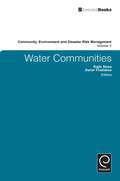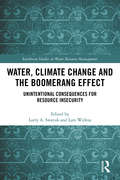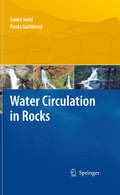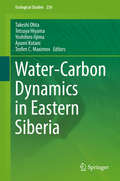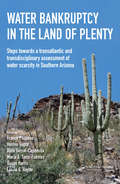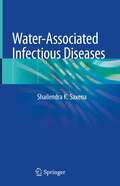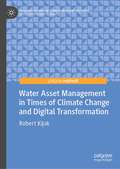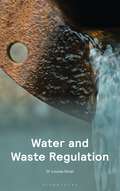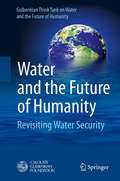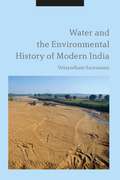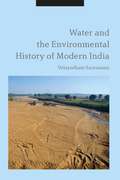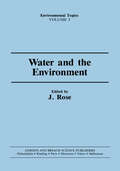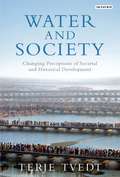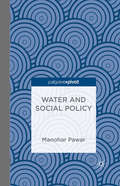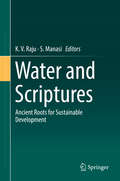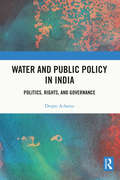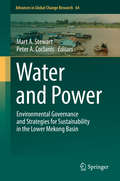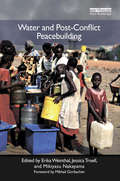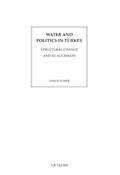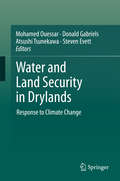- Table View
- List View
Water Communities (Community, Environment and Disaster Risk Management #2)
by Rajib Shaw Danai Thaitakoo Hari SrinivasWater is the key to human civilization. Most of the ancient civilization had its roots to river basins, where people-water interaction was the key aspect. Due to innovations of knowledge and technology and modernization of lifestyles, the human-water direct contact has become less significant. People have become more dependent to the system, and consequently, the closeness to water is gradually diminishing. It is however, a challenge on how to learn from the basic principles of water human interaction and apply those lessons to the current context of urban and rural settings. This book will provide a few analytical case studies on different aspects of water communities, which is defined as the human-water interaction process.
Water, Climate Change and the Boomerang Effect: Unintentional Consequences for Resource Insecurity (Earthscan Studies in Water Resource Management)
by Larry A. Swatuk Lars WirkusIn line with COP21 agreements, state-led climate change mitigation and adaptation actions are being undertaken to transition to carbon-neutral, green economies. However, the capacity of many countries for action is limited and may result in a ‘boomerang effect’, defined as the unintended negative consequences of such policies and programmes on local communities and their negative feedbacks on the state. To avoid this effect, there is a need to understand the policy drivers, decision-making processes, and impacts of such action, in order to determine the ways and means of minimizing negative effects and maximizing mutually beneficial policy outcomes. This book directly engages the policy debates surrounding water resources and climate actions through both theoretical and comparative case studies. It develops the ‘boomerang effect’ concept and sets it in relation to other conceptual tools for understanding the mixed outcomes of state-led climate change action, for example ‘backdraft’ effect and ‘maldevelopment’. It also presents case studies illustrative of the consequences of ill-considered state-led policy in the water sector from around the world. These include Africa, China, South Asia, South America, the Middle East, Turkey and Vietnam, and examples of groundwater, hydropower development and forest hydrology, where there are often transboundary consequences of a state's policies and actions. In this way, the book adds empirical and theoretical insights to a still developing debate regarding the appropriate ways and means of combating climate change without undermining state and social development.
Water, Climate Change and the Boomerang Effect: Unintentional Consequences for Resource Insecurity (Earthscan Studies in Water Resource Management)
by Larry Swatuk Lars WirkusIn line with COP21 agreements, state-led climate change mitigation and adaptation actions are being undertaken to transition to carbon-neutral, green economies. However, the capacity of many countries for action is limited and may result in a ‘boomerang effect’, defined as the unintended negative consequences of such policies and programmes on local communities and their negative feedbacks on the state. To avoid this effect, there is a need to understand the policy drivers, decision-making processes, and impacts of such action, in order to determine the ways and means of minimizing negative effects and maximizing mutually beneficial policy outcomes. This book directly engages the policy debates surrounding water resources and climate actions through both theoretical and comparative case studies. It develops the ‘boomerang effect’ concept and sets it in relation to other conceptual tools for understanding the mixed outcomes of state-led climate change action, for example ‘backdraft’ effect and ‘maldevelopment’. It also presents case studies illustrative of the consequences of ill-considered state-led policy in the water sector from around the world. These include Africa, China, South Asia, South America, the Middle East, Turkey and Vietnam, and examples of groundwater, hydropower development and forest hydrology, where there are often transboundary consequences of a state's policies and actions. In this way, the book adds empirical and theoretical insights to a still developing debate regarding the appropriate ways and means of combating climate change without undermining state and social development.
Water Circulation in Rocks
by Laura Scesi Paola GattinoniUnderstanding water circulation in rocks represents a very important element to solving many of the problems linked with civil, environmental and mining engineering. This book offers a synthesis of the actual knowledge about the fluid flow in rocks: - from the medium characterization and the structural geological survey to the generation of stereonets; - the evaluation of the hydrogeological parameters using either deterministic or probabilistic methodologies; - the evaluation of the preferential flow direction considering the change of the hydrogeological structures; - the methods and models used to simulate the flows. Three case studies are provided; water circulation and slope instability, hydrogeological risk linked with tunnelling, and hydrogeological risk linked with road construction.
Water-Carbon Dynamics in Eastern Siberia (Ecological Studies #236)
by Takeshi Ohta Tetsuya Hiyama Yoshihiro Iijima Ayumi Kotani Trofim C. MaximovThis book discusses the water and carbon cycle system in the permafrost region of eastern Siberia, Providing vitalin sights into how climate change has affected the permafrost environment in recent decades. It analyzes the relationships between precipitation and evapotranspiration, gross primary production and runoff in the permafrost regions, which differ from those intropical and temperate forests. Eastern Siberia is located in the easternmost part of the Eurasian continent, and the land surface with underlying permafrost has developed over a period of seventy thousand years. The permafrost ecosystem has specific hydrological and meteorological characteristics in terms of the water and carbon dynamics, and the current global warming and resulting changes in the permafrost environment are serious issues in the high-latitude regions. The book is a valuable resource for students, researchers and professionals interested in forest meteorology and hydrology, forest ecology, and boreal vegetation, as well as the impact of climate change and water-carbon cycles in permafrost and non-permafrost regions.
Water Bankruptcy in the Land of Plenty (IHE Delft Lecture Note Series)
by Franck Poupeau Hoshin Gupta Aleix Serrat-Capdevila Maria A. Sans-Fuentes László G. HaydeAs the American Southwest faces its deepest drought in history, this book explores the provocative notion of “water bankruptcy” with a view towards emphasizing the diversity and complexity of water issues in this region. It bridges between the narratives of growth and the strategies or policies adopted to pursue competing agendas and circumvent the inevitable. A window of opportunity provided by this current long-term drought may be used to induce change by dealing with threats that derive from imbalances between growth patterns and available resources, the primary cause of scarcity. A first of its kind, this book was developed through close collaboration of a broad range of natural scientists, social scientists, and resource managers from Europe and United States. It constitutes a collective elaboration of a transdisciplinary approach to unveiling the inner workings of how water was fought for, allocated and used in the American Southwest, with a focus on Arizona. Specifically, it offers an innovative scientific perspective that produces a critical diagnostic evaluation of water management, with a particular view to identifying risks for the Tucson region that is facing continuous urban sprawl and economic growth.
Water Bankruptcy in the Land of Plenty (IHE Delft Lecture Note Series)
by Franck Poupeau Hoshin V. Gupta Aleix Serrat-Capdevila Maria A. Sans-Fuentes Susan Harris László G. HaydeAs the American Southwest faces its deepest drought in history, this book explores the provocative notion of “water bankruptcy” with a view towards emphasizing the diversity and complexity of water issues in this region. It bridges between the narratives of growth and the strategies or policies adopted to pursue competing agendas and circumvent the inevitable. A window of opportunity provided by this current long-term drought may be used to induce change by dealing with threats that derive from imbalances between growth patterns and available resources, the primary cause of scarcity. A first of its kind, this book was developed through close collaboration of a broad range of natural scientists, social scientists, and resource managers from Europe and United States. It constitutes a collective elaboration of a transdisciplinary approach to unveiling the inner workings of how water was fought for, allocated and used in the American Southwest, with a focus on Arizona. Specifically, it offers an innovative scientific perspective that produces a critical diagnostic evaluation of water management, with a particular view to identifying risks for the Tucson region that is facing continuous urban sprawl and economic growth.
Water-Associated Infectious Diseases
by Shailendra K. SaxenaThis book provides a comprehensive overview of the different water-associated infectious diseases and their linked pathogens with plausible strategies for their mitigation. Although, we are in the era of 21st century having most of the advanced technologies at hand, yet water-associated infectious diseases are the major contributors towards the worldwide morbidity and mortality. The book also focuses on the various implementation strategies of sustainable hygienic conditions, discusses the robust, and reliable policies and strategies on a global aspect to provide unprivileged people access to the basic sanitation, hygiene and water. In addition, the book discusses the possible indirect effect of global warming on the spread of infectious diseases through the distribution of associated vectors.
Water Asset Management in Times of Climate Change and Digital Transformation (Palgrave Studies in Climate Resilient Societies)
by Robert KijakIn this book, climate change and digital transformation are explored as key strategic drivers for the contemporary practices of water utility companies. These drivers seem to be separate, but clearly, they are not.The recent weather anomalies in water stressed countries are discussed, which have been breaking records and become an elevated risk to water assets. In parallel, the book examines a contextual proposition that the concept of the fourth industrial revolution applied to the water sector, Water 4.0, assists with the water supply decentralisation and sustainability, in particular climate resilience. It further suggests that the implementation of an Asset Management System with reference to the ISO 55001 standard is a useful tool in this process.
Water and Waste Regulation
by Dr Louise SmailWater pollution law is the most developed of the pollution control systems. This title contains a comprehensive account of water and waste legislation plus a detailed interpretation of the relevant statutory provisions and associated case law.This book includes:- A detailed interpretation of the relevant statutory provisions and associated case law- The impact of Brexit on current regulations- Discussions surrounding UK desalination plants, end of life vehicles and nature conservation- The changes in international regulations and the impact that this has on UK water and waste regulation- The regulation of water quality standards, water pollution control, fisheries, navigation, flood, coastal protection and marine pollution with a wide range of water pollution offencesThe detailed treatment of the issues involved will enable environmental and energy law practitioners to feel confident in what is a complicated area of law.This title is included in Bloomsbury Professional's Environmental Law online service.
Water and the Future of Humanity: Revisiting Water Security
by Gulbenkian Think Tank on Water and the Future of HumanityThis unique, engaging, and highly authoritative volume enlightens readers on changes needed in the way society accesses, provides, and uses water. It further shines a light on changes needed in the way we use food, energy, and other goods and services in relation to water, and offers projections and recommendations, up to 2050, that apply to water access challenges facing the poor and the common misuse of water in industry, agriculture, and municipalities. Written by an unparalleled slate of experts convened by the Calouste Gulbenkian Foundation, the book takes on one of the most critical issues on the planet today. In a frank yet optimistic assessment of major developmental challenges, but also opportunities, facing future generations, the author elucidates linkages between water and a range of other drivers from various disciplinary and stakeholder perspectives. Ultimately portraying the belief that Humanity can harness its visionary abilities, technologies, and economic resources for increased wellbeing and sound stewardship of resources, the book presents an optimistic statement stressing actions scientists, policy makers, and consumers can and must take to meet the water management challenges of a warming planet anticipating nine billion inhabitants by 2050.Gulbenkian Think Tank on Water and the Future of Humanity: Benedito Braga, Pres. World Water Council & Prof. of Civil Engineering, Univ. of São Paulo, Brazil; Colin Chatres, Director General of the International Water Management Institute, Sri Lanka; William J. Cosgrove, Pres. of Ecoconsult Inc. & Senior Adviser for the UN World Water Development Report, Canada; Luis Veiga da Cunha, Prof. Environmental Science and Engineering, Universidade Nova de Lisboa, Portugal; Peter Gleick, Pres. of the Pacific Institute, USA; Pavel Kabat, Director, International Institute for Applied Systems Analysis, Austria; and Prof. & Chair, Earth Systems Science, Wageningen University, The Netherlands; Mohamed Ait Kadi, President of the General Council of Agricultural Development, Morocco; Daniel P. Loucks, Prof. of Civil Engineering, Cornell Univ. USA; Jan Lundqvist, Senior Scientific Advisor, Stockholm International Water Institute, Sweden; Sunita Narain, Director, Center for Science & Environment, New Delhi, India; Jun Xia, Pres., International Water Resources Association, Chair Prof. & Dean, The Research Institute for Water Security (RIWS), Wuhan University, China.
Water and the Environmental History of Modern India
by Velayutham SaravananThis important new study investigates the competing demand for water in the Bhavani and Noyyal River basins of south India from the early 19th century to the early 21st century from a historical perspective. In doing so, the book addresses several important questions: * Did policy-makers visualise the future demand while diverting water from distant places or other basins?* Was efficient use ensured when the water was diverted or was it diverted in a manner that resulted in pollution and serious damage to the entire river basin?* Were natural flows taken care of in order to preserve the ecology and environment?* What were the factors that aggravated the competing demand for water and what were the consequences for the future? In the context of the current discourse on the competing demands for water, this book takes the debate forward, expanding the horizon of environmental history in the process. Until now, agriculture, industry and domestic water supply and their consequences for ecology, the environment and livelihoods have been given scant attention. Velayutham Saravanan's comprehensive account of both the colonial and post-colonial periods corrects this shortcoming in the field's literature and gives a holistic understanding of the problem and its full historical roots.
Water and the Environmental History of Modern India
by Velayutham SaravananThis important new study investigates the competing demand for water in the Bhavani and Noyyal River basins of south India from the early 19th century to the early 21st century from a historical perspective. In doing so, the book addresses several important questions: * Did policy-makers visualise the future demand while diverting water from distant places or other basins?* Was efficient use ensured when the water was diverted or was it diverted in a manner that resulted in pollution and serious damage to the entire river basin?* Were natural flows taken care of in order to preserve the ecology and environment?* What were the factors that aggravated the competing demand for water and what were the consequences for the future? In the context of the current discourse on the competing demands for water, this book takes the debate forward, expanding the horizon of environmental history in the process. Until now, agriculture, industry and domestic water supply and their consequences for ecology, the environment and livelihoods have been given scant attention. Velayutham Saravanan's comprehensive account of both the colonial and post-colonial periods corrects this shortcoming in the field's literature and gives a holistic understanding of the problem and its full historical roots.
Water and the Environment
by J. RoseThis compilation of papers provides useful insights on the differing approaches to water quality and the diversity of strategies in water quality management worldwide. Considering the current situation and looking to the future, the aim of this publication is to provide a sensible addition to the literature by concentrating on several important aspects of water and the environment.
Water and the Environment
by J. RoseThis compilation of papers provides useful insights on the differing approaches to water quality and the diversity of strategies in water quality management worldwide. Considering the current situation and looking to the future, the aim of this publication is to provide a sensible addition to the literature by concentrating on several important aspects of water and the environment.
Water and Society: Changing Perceptions of Societal and Historical Development (International Library of Human Geography)
by Terje TvedtDespite the central importance that water has held for civilizations both ancient and modern, its social significance has made surprisingly little impact on our contemporary understanding of human history and development. Dominant interpretations of the relationship between society and nature have remained water blind. In Water and Society historian and leading water expert Terje Tvedt argues for a change that acknowledges the significant role played by water in societal development.
Water and Social Policy
by M. PawarManohar Pawar discusses the relevance and importance of social policy for water issues. By analysing several interrelated perspectives on water, he suggests core values as bases for formulating and implementing social policies so as to provide universal free access to safe drinking water for all, particularly for the most poor and disadvantaged.
Water and Scriptures: Ancient Roots for Sustainable Development
by K. V. Raju S. ManasiThis collection of papers aims to draw lessons and apply indigenous knowledge, wisdom and cultural traditions to suit policy contexts describing the (a) role of individuals (b) communities, and (c) the state to ensure effectively manage water resources. Readers will discover ways in which water was conceptualized, conserved and managed. Contributions will also shed light on the historical, functional and futuristic perspectives of water resources management, and readers will be able to draw lessons and evolve policy guidelines.There are some studies related to scriptures across religions and their perceptions regarding ecological conservation. However, religious studies and their socio-economic and environmental relevance to society, more specifically to the current policy contexts, are limited. This book attempts to bridge this gap, in terms of learning lessons from the past to effectively address the challenges of the present and future. The book will be useful for historians and research scholars studying the place of water in different cultures, water pricing and water sharing; as well as ecologists and environmental scientists.
Water and Public Policy in India: Politics, Rights, and Governance
by Deepti AcharyaThis book explores the conceptual and theoretical frameworks of Right to Water and analyzes its values in the context of water policy frameworks of the union governments in India. It uses a qualitative approach and combines critical hermeneutics with critical content analysis to introduce a new water policy framework. The volume maps the complex argumentative narrations which have emerged and evolved in the idea of Right to Water and traces the various contours and the nature of water policy texts in independent India. The book argues that the idea of Right to Water has emerged, evolved and is being argued through theoretical arguments and is shaped with the help of institutional arrangements developed at the international, regional, and national levels. Finally, the book underlines that India’s national water policies drafted respectively in 1987, 2002 and 2012, are ideal but are not embracing the values and elements of Right to Water. The volume will be of critical importance to scholars and researchers of public policy, environment, especially water policy, law, and South Asian studies.
Water and Public Policy in India: Politics, Rights, and Governance
by Deepti AcharyaThis book explores the conceptual and theoretical frameworks of Right to Water and analyzes its values in the context of water policy frameworks of the union governments in India. It uses a qualitative approach and combines critical hermeneutics with critical content analysis to introduce a new water policy framework. The volume maps the complex argumentative narrations which have emerged and evolved in the idea of Right to Water and traces the various contours and the nature of water policy texts in independent India. The book argues that the idea of Right to Water has emerged, evolved and is being argued through theoretical arguments and is shaped with the help of institutional arrangements developed at the international, regional, and national levels. Finally, the book underlines that India’s national water policies drafted respectively in 1987, 2002 and 2012, are ideal but are not embracing the values and elements of Right to Water. The volume will be of critical importance to scholars and researchers of public policy, environment, especially water policy, law, and South Asian studies.
Water and Power: Environmental Governance And Strategies For Sustainability In The Lower Mekong Basin (Advances In Global Change Research #64)
by Peter A. Coclanis Mart A. StewartThis book brings together a talented international group of scholars, policy practitioners, and NGO professionals that explores a range of issues relating to environmental, developmental, and governing challenges on the Mekong, one of the world’s greatest rivers and, alas, one of the most endangered. The book is divided into three sections devoted in turn to historical perspectives on the Lower Mekong Basin. Issues relate to livelihood strategies, environmental threats, and adaptation strategies; and various aspects of river governance, with individual authors treating questions of governance at different levels of refraction and in different registers. The result is a fresh and innovative collection of essays, which, taken together, provide much-needed new perspectives on some of the most important and seemingly intractable environmental and development issues in contemporary Asia.
Water and Post-Conflict Peacebuilding (Post-Conflict Peacebuilding and Natural Resource Management)
by Erika Weinthal Jessica J. Troell Mikiyasu NakayamaWater is a basic human need, and despite predictions of "water wars," shared waters have proven to be the natural resource with the greatest potential for interstate cooperation and local confidence building. Indeed, water management plays a singularly important role in rebuilding trust after conflict and in preventing a return to conflict. Featuring nineteen case studies and analyses of experiences from twenty eight countries and territories in Africa, Asia, Europe, the Americas, and the Middle East, and drawing on the experiences of thirty-five researchers and practitioners from around the world, this book creates a framework for understanding how decisions governing water resources in post-conflict settings can facilitate or undermine peacebuilding. The lessons will be of value to practitioners in international development and humanitarian initiatives, policy makers, students, and others interested in post-conflict peacebuilding and the nexus between water management and conflict. Water and Post-Conflict Peacebuilding is part of a global initiative to identify and analyze lessons in post-conflict peacebuilding and natural resource management. The project has generated six edited books of case studies and analyses, with contributions from practitioners, policy makers, and researchers. Other books in this series address high-value resources, land, livelihoods, assessing and restoring natural resources, and governance.
Water and Post-Conflict Peacebuilding (Post-Conflict Peacebuilding and Natural Resource Management)
by Erika Weinthal Jessica Troell Mikiyasu NakayamaWater is a basic human need, and despite predictions of "water wars," shared waters have proven to be the natural resource with the greatest potential for interstate cooperation and local confidence building. Indeed, water management plays a singularly important role in rebuilding trust after conflict and in preventing a return to conflict. Featuring nineteen case studies and analyses of experiences from twenty eight countries and territories in Africa, Asia, Europe, the Americas, and the Middle East, and drawing on the experiences of thirty-five researchers and practitioners from around the world, this book creates a framework for understanding how decisions governing water resources in post-conflict settings can facilitate or undermine peacebuilding. The lessons will be of value to practitioners in international development and humanitarian initiatives, policy makers, students, and others interested in post-conflict peacebuilding and the nexus between water management and conflict. Water and Post-Conflict Peacebuilding is part of a global initiative to identify and analyze lessons in post-conflict peacebuilding and natural resource management. The project has generated six edited books of case studies and analyses, with contributions from practitioners, policy makers, and researchers. Other books in this series address high-value resources, land, livelihoods, assessing and restoring natural resources, and governance.
Water and Politics in Turkey: Structural Change and EU Accession (20160728 Ser. #20160728)
by Vakur SumerAs Turkey approaches EU membership it faces the challenge of implementing the requirements of the WFD by the date of its accession to the union, something that will require major structural change and financial investment. Water and Politics in Turkey provides a comprehensive, detailed and authoritative examination of all aspects water management and water resources in Turkey, from evaluation of existing institutions and practices to assessing the difficulties inherent in the enormous changes that must be implemented as Turkey prepares for EU membership. It will be essential reading for water professionals, policy makers, environmentalists, and all those with an interest in Turkey the workings of the European Union.
Water and Land Security in Drylands: Response to Climate Change
by Mohamed Ouessar Donald Gabriels Atsushi Tsunekawa Steven EvettThis book presents recent lessons learned in the context of research and development for various dryland ecosystems, focusing on water resources management, land and vegetation cover degradation and remediation, and socioeconomic aspects, as well as integrated approaches to ensuring water and land security in view of the current and predicted climate change. As water and land are the essential bases of food production, the management of these natural resources is becoming a cornerstone for the development of dryland populations. The book gathers the peer-reviewed, revised versions of the most outstanding papers on these topics presented at the ILDAC2015 Conference in Djerba, Tunisia.
